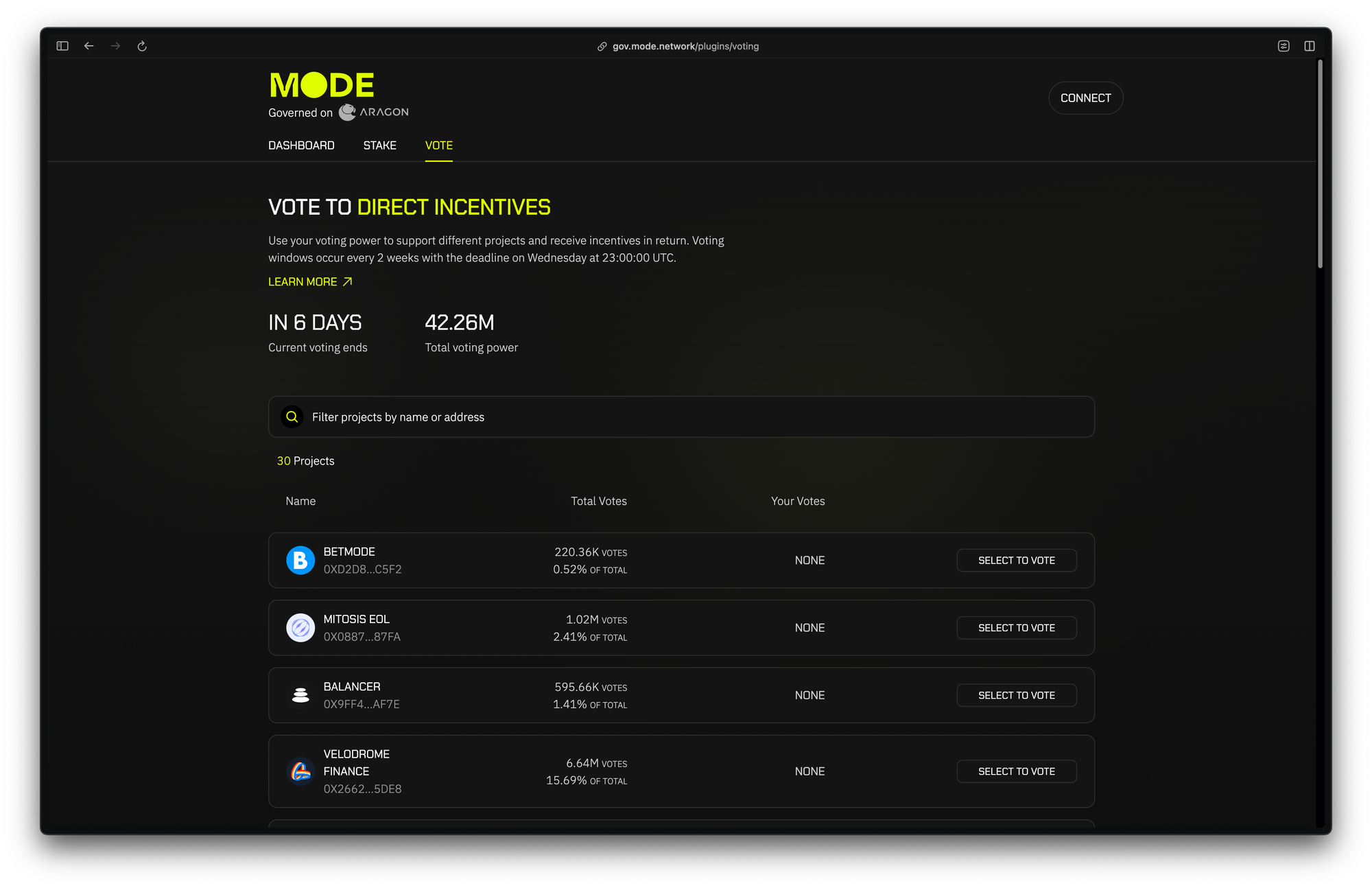Mode Governance Games Drive High Voter Participation
Mode became the first L2 to introduce vote escrow (ve) and gauge-based governance to its ecosystem—modernizing a long-standing governance model implemented by successful DeFi protocols. In Season 3, the Governance Games incentivized community members to stake tokens for increased voting power, directing rewards to protocols via gauges. The results are exciting:
- 43% of circulating supply staked
- 7.6K+ unique voters participated
- 31K+ votes cast via gauges
Here’s how Mode addressed persistent challenges in L2 governance to achieve high participation rates:
Token-based delegate voting—a common onchain governance model for L2s—faces significant challenges:
- Misaligned incentives: Delegates often lead governance decisions but may not have sufficient “skin in the game,” creating potential conflicts with builders and token holders.
- Coordination overhead: Meeting quorum and approval thresholds demands frequent, time-consuming votes across numerous proposals.
- Low participation: Voter fatigue leads most token holders and many delegates to disengage, leading to low participation rates, failed proposals, and lack of accountability.
These issues reduce the effectiveness of governance decisions and discourage broad community participation, undermining alignment between stakeholders.
To address the challenges of traditional onchain governance, Mode introduced a modernized ve and gauge-based governance model—drawing inspiration from DeFi governance, lessons from past Seasons, and working alongside experts from Aragon, Balancer, and Aura.
At the core of this model: community members stake tokens to gain voting power (represented as veTokens), which they can allocate to gauges. Gauges determine how rewards are distributed across protocols in the network. This design removes the need for continuous voting while offering voters flexibility to reallocate their power each epoch.
Mode’s implementation incorporated unique features to adapt the governance model to the needs of their community:
- Flexible Voting with Linear Curve: Voting power increases linearly the longer tokens are staked. However, there are no mandatory lockups—token holders can stake or unstake anytime, subject to warm-up and cool-down periods.
- Dual Token Staking: Both MODE and BPT (Balancer’s 80/20 MODE-ETH pool tokens) can be staked. This unlocks dual governance incentives, enabling dynamic voting power for multiple stakeholder groups.
- Protocol-Centric Rewards: Instead of directing rewards to liquidity pools, stakers allocate voting power to protocols via gauges, incentivizing ecosystem growth.
- Governance Hub: A streamlined hub where community members can stake, vote, and claim rewards simplifies the governance process for all participants.
The incentives for both veMODE and protocols adapt from season to season, keeping governance responsive and adaptable to ecosystem and market dynamics.
Mode built its governance on Aragon OSx, a modular DAO framework enabling secure and customizable governance solutions.
ve Contract Library
To simplify otherwise complex implementations of ve governance, the Aragon team built a modularized ve contract library, allowing Mode to customize key parameters efficiently and safely, without needing to draw on resources from their development team.
The architecture includes a core contract that acts as the controller, managing the main staking and unstaking logic while connecting to sub-contracts that handle specific components:
- NFT Logic: Each stake is represented as an NFT.
- Curve Logic: Manages linear or dynamic escrow logic in Solidity.
- Clock Logic: Defines epochs, checkpoints, and timing mechanisms.
- Queue Logic: Oversees exit queues and conditions.
- Voting Logic: Connects ve tokens to governance mechanisms.

Gauges Governance Plugin
Mode used Aragon OSx’s plugin architecture to deploy its gauge-based governance system. The plugin enables veToken holders to allocate their voting power to a predetermined list of gauges, setting a percentage of their voting power to direct rewards to protocols. Once voting power is allocated, there’s no need for repetitive votes—holders simply reallocate as needed at the start of each epoch.
The modularity of Aragon OSx allows Mode to adapt with learnings. Plugins can be installed, updated, or removed as the community and ecosystem evolve. This flexibility is critical for Mode’s seasonal governance, where learnings from one season shape the next.
Aragon OSx empowers governance innovation with a secure, modular framework. By modularizing ve contracts, Aragon makes it simple for projects to customize governance models to fit their ecosystems and communities.
Want to implement a custom ve model for your project? Reach out here.


